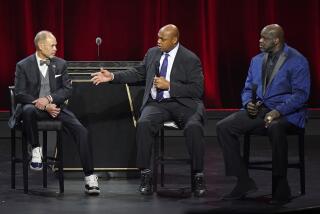Too much ‘digital,’ not enough ‘TV’
The looming start of the pro football season makes me yearn for a new TV set, one that will display the exploits of Joey Harrington in lush detail and vivid color. But I’m going to hold onto my 10-year-old Toshiba for a while longer -- not because I think Harrington’s going to get better with age, but because I think TV will. In fact, to strain the football analogy, I think TV sets aren’t even close to fulfilling their potential.
The Federal Communications Commission changed the nature of the home entertainment device back in 1997, when it adopted a far-reaching rule requiring television stations to switch from analog broadcasting to digital within a decade (a deadline that Congress later pushed back to February 2009). Then-chairman Reed Hundt saw the switch to digital as bringing much more to consumers than just the sharper pictures and better sound of high-definition TV. Instead, Hundt argued, broadcasters would use the new flexibility to transform their channels into multi-product information pipelines.
At the time, Microsoft was pushing broadcasters hard to deliver interactive entertainment to PCs over their new channels. And some stations, most notably PBS affiliates, have experimented with new approaches to TV -- they’ve divided their digital channels in subchannels carrying multiple programs, or they’ve transmitted computer dataover a slice of their airwaves. For the most part, though, the focus of broadcasters, cable and satellite operators and TV manufacturers has been on HDTV.
The mere act of changing the transmission standard to digital has led manufacturers to produce sets that can display much more than your parents’ cathode ray tubes could. Unlike their analog precursors, the new models have no trouble with digital image and video formats. Given the right feed, they can handle anything your PC monitor can display -- YouTube videos, digital photos, instant messages, even Second Life excursions. And thanks to thin and light technologies such as plasma and LCD, the screens are growing large enough to display several things at once. If you wanted to get a couple of chat sessions going with distant friends while you all watched the same football game, you could do that on a 50-inch screen without obscuring any part of the program.
The missing piece is the ability to plug the Internet into the TV. You can plug in a cable TV wire or a rooftop antenna, not an Ethernet cable or WiFi dongle. There are a few exceptions, such as HP’s MediaSmart TVs, but even these hybrids can’t handle decode the variety of formats that a computer can.
Several consumer electronics companies have started moving in HP’s direction. A good example is Sony, which this year launched an enhanced version of its Bravia sets with a plug-in module called Internet Video Link. The module lets viewers tune in selected video sites from the Web without the aid of a computer. That’s great, except for the “selected” part. The best thing about the Web is that its low barriers to entry enable a steady influx of new sites and business models. Any TV that limits users to a predetermined list of sites is going to feel less enhanced and more handicapped as time goes by.
One reason for this shortcoming is that giving TVs the Web-surfing capabilities of a PC would add significant cost and complexity. Manufacturers have preferred to shift the necessary circuitry and software from the set to a set-top box, such as Netgear’s Digital Entertainer HD or Apple’s Apple TV. Even these devices, though, tend to support only a portion of the Web and its abundant video services. That’s true in part because the online video sites backed by Hollywood have split into two camps, with most using Microsoft’s anti-piracy software, and Apple’s iTunes Store using its own. That wouldn’t be such a big deal if the iTunes Store weren’t so popular, but the fact of the matter is that it sells millions of TV episodes and movies a month.
Of course, you can always buy a Mac or a PC with a TV tuner card in it and connect your HDTV to that. The first cable-ready PCs, which arrived earlier this year, are breathtakingly expensive -- more costly, in fact, than many 42-inch plasma sets. Short of that, the latest generation of video game consoles are morphing into devices that can bridge the gap between your TV screen and the Internet or home network. Sony recently unveiled PlayTV, an add-on for the PlayStation 3 that lets the console record TV shows and transmit them to Sony’s portable game devices through a home network. And Microsoft has been selling TV shows and movies through its XBox Live Marketplacefor people to download to their XBox 360 consoles and watch on their TVs.
Given the cost of a digital TV, it may be wiser to rely on a game machine or set-top box to bring out an HDTV’s untapped potential. After all, a $200 device that goes obsolete in a year or two causes far less pain than a short-lived $2,500 plasma set. Nevertheless, I can’t help hoping that Sony or some other manufacturer will pull all the pieces together for me in a device that can search for and retrieve programming online and off. I’d also like it to let me chat while I watch too. In short, I want it to be another window into the expanding, interactive world of video entertainment, only bigger. Is that too much to ask?
Jon Healey is a member of The Times’ editorial board and author of the BitPlayer blog; to read more of his Opinion Daily columns. Send us your thoughts at opinion@latimes.com.
More to Read
A cure for the common opinion
Get thought-provoking perspectives with our weekly newsletter.
You may occasionally receive promotional content from the Los Angeles Times.







